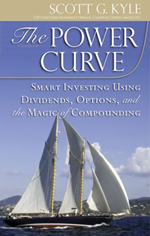“The Power Curve — Smart Investing Using Dividends, Options and the Magic of Compounding”

By Scott G. Kyle
Reviewed by Kris Grant
On first blush, one might think that Scott Kyle couldn’t have picked a worse time to publish a book on investing in the stock market. But then he points out that since his book, “The Power Curve – Smart Investing Using Dividends Options and the Magic of Compounding” was published, Microsoft went from 16 to 24 — a 50 percent rise in just six months.
That fast-clipped rise is one reason Kyle suggests that investors not move stocks rapidly in and out of the market. “The reality is that no one can accurately gauge what will happen in the short term.”
Kyle is the CEO and chief investment officer of Coastwise Capital Group, LLC, a boutique money management firm based in La Jolla. He also was cofounder in 1998 of The Active Network Inc., a sports management and technology company that today has more than 3,000 employees.
His education is impressive, with degrees in economic and international relations from Tufts University (magna cum laude and Phi Beta Kappa), a general course degree in international relations from the London School of Economics and an MBA from Harvard. Yet his smarts are balanced with physical pursuits — he’s a world champion sailor and an Ironman triathlon finisher — and his sports analogies that pepper his book’s eight chapters make it an entertaining and easy read.
Here’s a book that speaks to the non-CPA crowd, the masses who yearn for that 8 percent (or more), annual return but can’t seem to beat (or meet) the market. It’s a book that you’ll want to attack with a highlighter to help important concepts crack through thick skulls, like:
Good companies with strong balance sheets will survive challenging times and will likely continue to increase their dividends while they are sorting things out. Always invest in the strongest companies within a given industry.
Much of people’s attention is focused on aspects of the stock market over which they have no control. He points out that “even if you were Warren Buffett, there is not one single thing you can do to influence, much less control, the movement of the U.S. stock market for even a single day.” Instead, Buffett focuses on the fundamentals of a given company.
Deciding against a particular investment can be of tremendous value. “Returns are affected as much, if not more, by the mistakes that we make, the things we did but should not have done, than by the things we did right. Yet no one cheers when I say no to an investment opportunity after much consideration.
Listen to your emotions and do the opposite of what your gut is telling you.
And his book is also laced with power tips: Whatever the big mutual fund companies are not pushing is often a good place to look for investment opportunities. Another: Don’t get stung – let options be your pilot. “Most people have personal trainers nut because they are clueless about how to use weight machines, but because they need an external source of discipline to keep making smart physical choices. The sale of covered call options can be like your personal trainer — it impels disciplined sales at predetermined levels.”
“Investing is just a means to an end,” says Kyle, noting that a person’s time horizon is a strong determinant in what type of investments he should make. “If your house is on fire, you don’t warm up and stretch. One of the primary mistakes investors make is mismatching their time horizon and investments.” z
